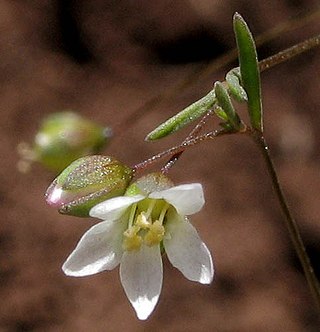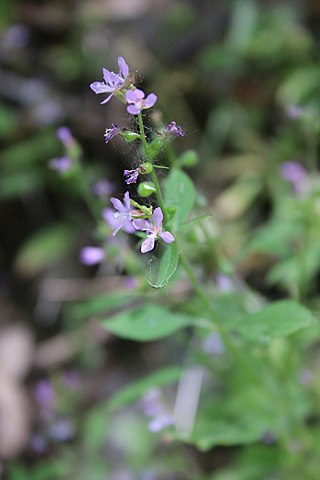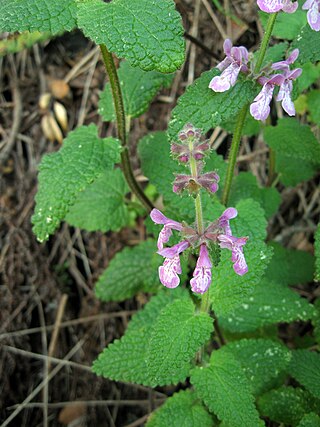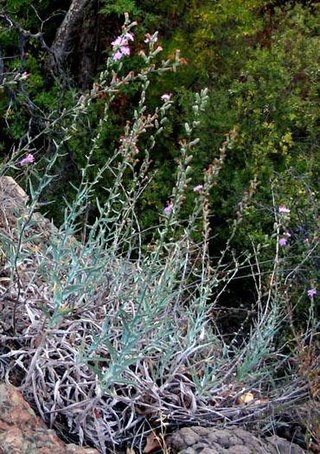
Phacelia fremontii is a flowering plant in the family Boraginaceae native to the southwestern United States. In California, its range includes the Mojave Desert, the San Joaquin Valley, the Coast Ranges, and the Sierra Nevada. It was named for John C. Frémont.

Hesperolinon is a genus in the family Linaceae, whose common genus names are dwarf-flax or western flax, in reference to their distribution along the west coast of North America. There are 13 known species within this genus of wildflowers, most of which are limited to serpentine soil habitats within California, United States. These annual plants are thought to be mostly self-pollinating.

Hesperolinon congestum, or Marin dwarf flax, is an annual herb, which is known to occur only in San Mateo, San Francisco and Marin County, California, United States. This plant occurs chiefly on serpentine soils, especially in dry native bunch grasses, chaparral or other grasslands at elevations less than 200 meters. The flowers are congested at the tips of the dichotomously branching stems. H. congestum is in flower between April and July. The outlook for this plant depends on survival of only about twenty small colonies, most of which are not actively managed for protection, even though the species is federally and state-listed as threatened. This species is also less commonly known as Marin western flax.

Gilia capitata is a species of flowering plant in the phlox family known by the common names blue-thimble-flower, bluehead gilia, blue field gilia, and globe gilia.
Hesperolinon adenophyllum is a rare species of flowering plant in the flax family known by the common names glandular dwarf flax and glandular western flax. It is endemic to California, where most known occurrences have been recorded in Lake and Mendocino Counties. It is generally found in chaparral ecosystems on serpentine soils. This is an annual herb growing erect to heights between 10 and 50 centimeters. Its narrow, lance-shaped leaves are lined with rows of teeth with large knobby glandular points. The flower has small sepals speckled with glandular hairs and five thin yellow petals. The stamens protrude from the face of the flower and hold large yellow anthers.
Hesperolinon californicum is a species of flowering plant in the flax family known by the common name California dwarf flax. It is endemic to California, where it grows in the coastal mountains and hills surrounding the San Francisco Bay Area and some of the foothills of the Sierra Nevada. It is found in grassland and chaparral ecosystems, often on serpentine soils. This is an annual herb growing erect to 10 to 25 centimeters in height. It has thin, narrow to threadlike leaves and produces a red exudate from resin glands located at the base of leaf petioles. The inflorescence holds several flowers with glandular sepals and five white to pink-tinged petals. The protruding stamens are tipped with large pink anthers.
Hesperolinon drymarioides is a rare species of flowering plant in the flax family known by the common names drymary dwarf flax and drymaria-like western flax; it is named for its resemblance to genus Drymaria. It is endemic to California, where it grows in the central inland North Coast Range. Most of the few known occurrences have been noted in Lake County. It is a plant of serpentine soils in chaparral and woodland ecosystems. This is a small annual herb growing a thin branching brown stem low to the ground or erect to about 20 centimeters in height. Leaves appear in whorls of four on the lower part of the stem and are dark reddish green with plentiful glandular hairs. Its flowers have light pink-veined white petals in a corolla about a centimeter across. Protruding stamens hold large yellow or purplish-white anthers.

Hesperolinon micranthum is a species of flowering plant in the flax family known by the common name smallflower dwarf flax. It is native to the west coast of North America from Oregon to Baja California. It may occur in Nevada. It grows in a number of open habitats, often on serpentine soils. This is a spindly annual herb producing a very thin stem 5 to 20 centimeters in height. Its small, sparse leaves are linear in shape. The tiny flowers have five white or pink-veined white petals each less than four millimeters long and protruding stamens with white or purple anthers.
Hesperolinon serpentinum is a rare species of flowering plant in the flax family known by the common name Napa dwarf flax, or Napa western flax. Hesperolinon serpentinum was not validly published by McCarten although it appears in the Jepson Manual. The species was validly published as Hesperolinon sharsmithae in 2006 by O'Donnell. The species is endemic to northern California, where it is known from fewer than twenty occurrences in four counties surrounding the San Francisco Bay Area. It is a member of chaparral plant communities, generally on serpentine soils. It produces a thin, erect stem up to 30 centimeters tall, with sparse flat, narrow leaves. The inflorescence holds several light yellow flowers with petals only 2 or 3 millimeters long. The plant is threatened mainly by development of its habitat.
Hesperolinon tehamense is a rare species of flowering plant in the flax family known by the common names Tehama County western flax and Paskenta Grade dwarf flax. It is endemic to northern California, where it is known from only about ten occurrences, mostly within Tehama and Glenn Counties. Most of its habitat is on Bureau of Land Management lands and within the Mendocino National Forest, in chaparral ecosystems with serpentine soils. The plant produces thin, hairy stems up to 50 centimeters in maximum height with small, sparse linear leaves. The inflorescence bears several small flowers with pale to bright yellow notched petals just a few millimeters long.

Arctostaphylos nummularia is a species of manzanita known by the common names glossyleaf manzanita, dwarf manzanita and Fort Bragg manzanita. It is endemic to California, where it grows in the forests of the coastal and inland ranges north of the San Francisco Bay.

Calycadenia villosa is an uncommon species of flowering plant in the family Asteraceae known by the common name dwarf western rosinweed. It is endemic to central California, where it is known from a limited distribution in the Central Coast Ranges in Monterey County and San Luis Obispo County, with a few populations in Santa Barbara and western Fresno Counties. There are perhaps 16 occurrences.

Clarkia heterandra is a species of flowering plant in the family Onagraceae known by the common name mountain clarkia. It is endemic to California, where it is from the forests and woodlands of several of eastern and western mountain ranges. It is an annual herb producing an erect, glandular stem to around half a meter in maximum height. The lance-shaped to oval leaves are up to 8 centimeters long and are borne on petioles of up to 2 centimeters. The top of the stem is occupied by the inflorescence, with open flowers and closed buds. The sepals remain fused as the flower blooms from one side. The pink petals are oval in shape and just a few millimeters long. There are 8 stamens, some large and some small and sterile. The fruit is a small, hard body 2 or 3 millimeters long containing 1 or 2 seeds.
Lessingia tenuis is a species of flowering plant in the family Asteraceae known by the common name spring lessingia. It is endemic to California, where it is known from the San Francisco Bay Area to Ventura County. It grows on the slopes of the California Coast Ranges in common local habitat such as chaparral.

Ribes indecorum is a species of currant known by the common names white-flowered currant and white chaparral currant. It is native to the southern California Coast Ranges, Transverse Ranges, and Peninsular Ranges, from around Santa Barbara County in California south into northern Baja California.

Rosa bridgesii is a species of rose known by the common names pygmy rose and Sierran dwarf rose. It is native to California, where it grows in the forests of the Sierra Nevada and surrounding mountains and foothills. It may also occur in Oregon.

Stachys bullata is a species of flowering plant in the mint family known by the common name California hedgenettle.

Stephanomeria cichoriacea is a species of flowering plant in the family Asteraceae; it is known by the common names chicoryleaf wirelettuce and silver rock-lettuce. It is endemic to California, where it grows in the coastal mountain ranges as far north as Monterey County, but especially in southern California mountains such as the Transverse Ranges. Its habitat includes chaparral. It is a perennial herb producing slender erect stems reaching maximum heights exceeding one meter. The stem is woolly with hairs, especially on new growth. The leaves are mostly located in a basal rosette, the largest reaching 18 to 20 centimeters long. They are lance-shaped and often toothed along the edges, and the newer ones are woolly. Smaller leaves occur farther up the stem. The inflorescence is a long array of several flower heads, with some occurring in the upper leaf axils as well. Each head has a cylindrical base 1 to 2 centimeters long which is lined with layers of glandular phyllaries. The head contains 10 to 15 ray florets, each with an elongated tube and a pink ligule which may be up to 2 centimeters long. The fruit is an achene tipped with a spreading cluster of long, plumelike pappus bristles.
Stephanomeria elata is a species of flowering plant in the family Asteraceae known by the common names Santa Barbara wirelettuce and Nuttall's wirelettuce. It is native to Oregon and California, where it grows in coastal and inland mountain ranges, including the Sierra Nevada. It can be found in many types of habitat. It is an annual herb producing a slender, erect stem often exceeding one meter in maximum height. It is hairy to hairless and often glandular. The leaves are mostly located in a basal rosette, the largest reaching 10 centimeters long. Smaller, much-reduced leaves occur farther up the stem. The leaves drop early, leaving the plant naked for most of the year. Flowers occur singly or in small clusters along the stiff branches. Each head contains up to 15 or 16 ray florets, each with an elongated tube and a pink ligule 6 or 7 millimeters long. The fruit is an achene tipped with a spreading cluster of long, plumelike pappus bristles.

North American azaleas are flowering shrubs in the genus Rhododendron, section Pentanthera, subsection Pentanthera, so named because they all have five stamens. Most are in the United States, with one species found in Canada and one being found in Mexico. North American azaleas are commonly confused with azaleas of Asian origin, the evergreen azaleas. North American azaleas are deciduous and produce two types of buds. One is a larger and produces about 20 flowers while the other bud produces a leafy shoot. The flower color, fragrance, and number of stamens vary among species.












